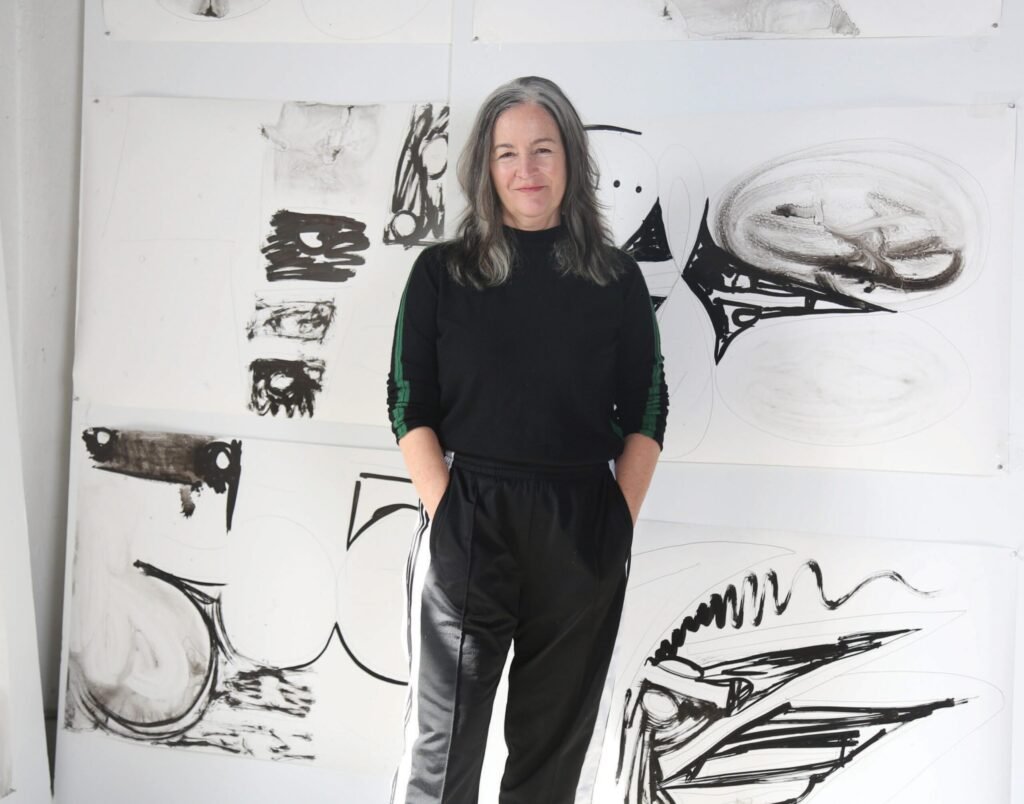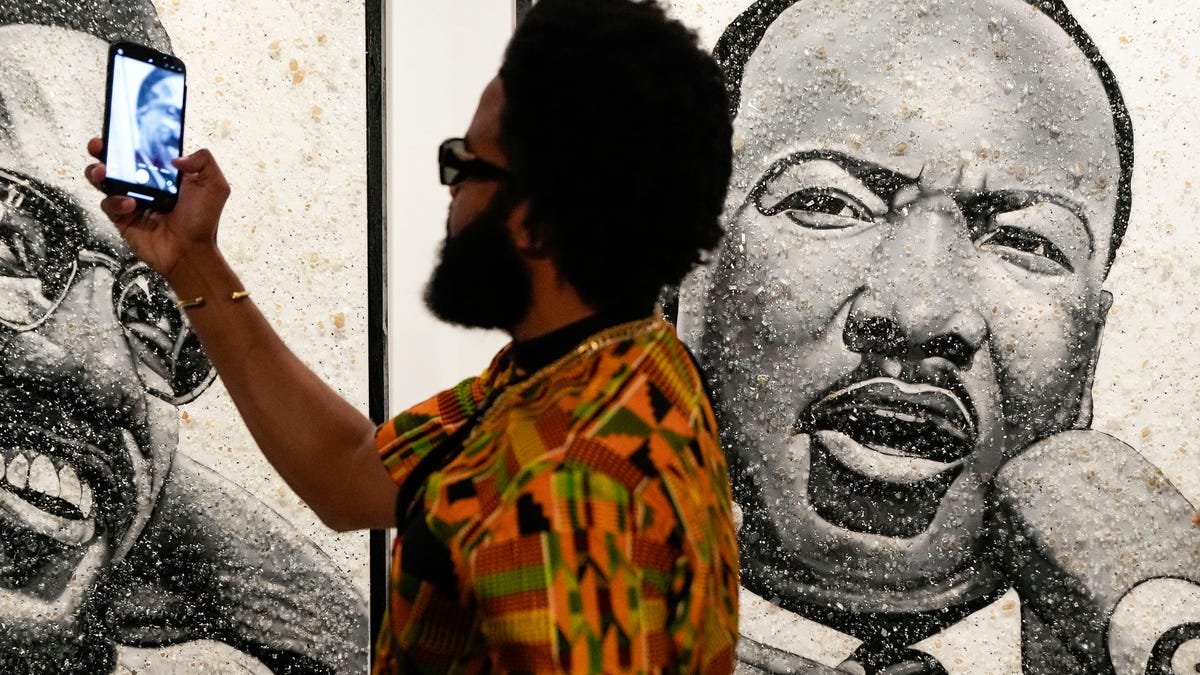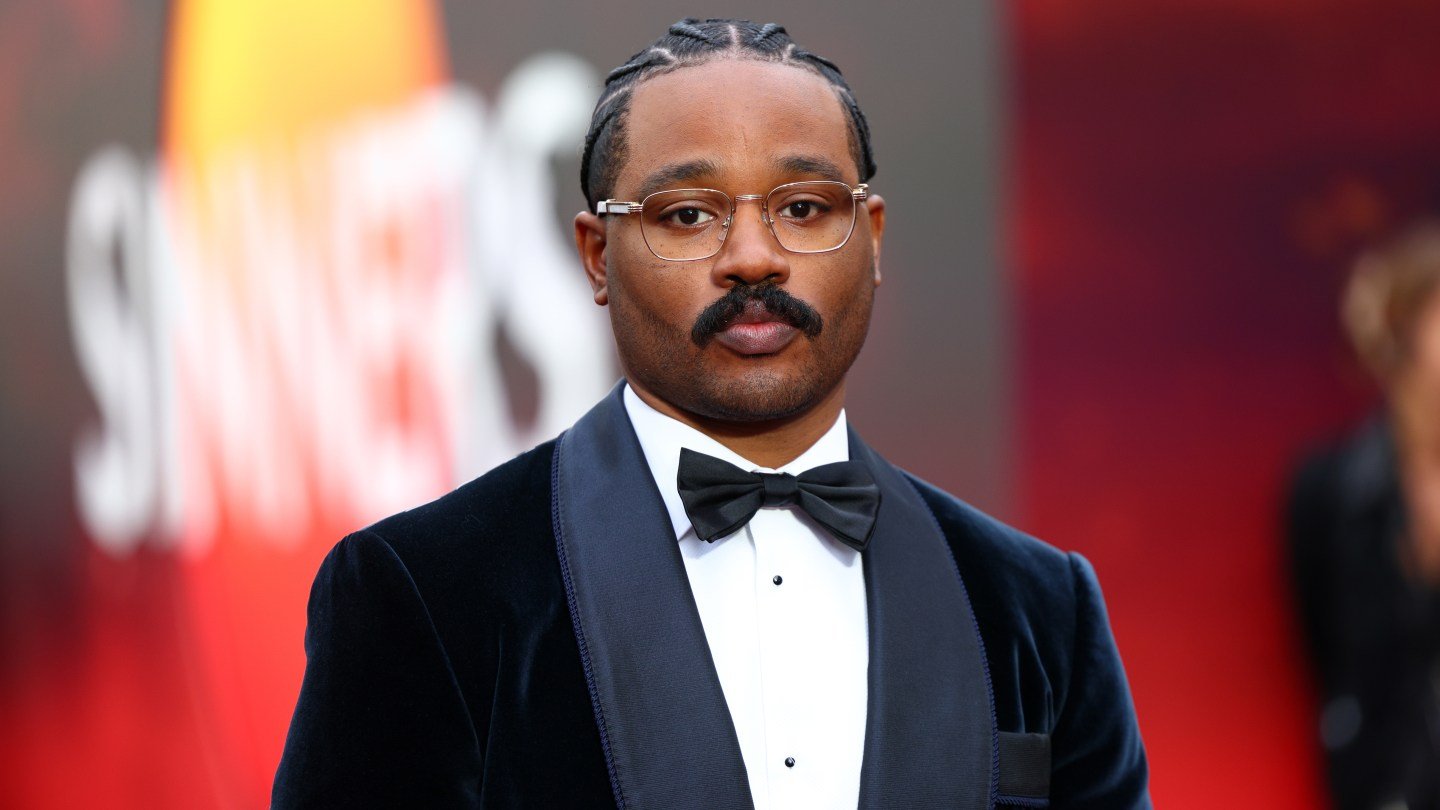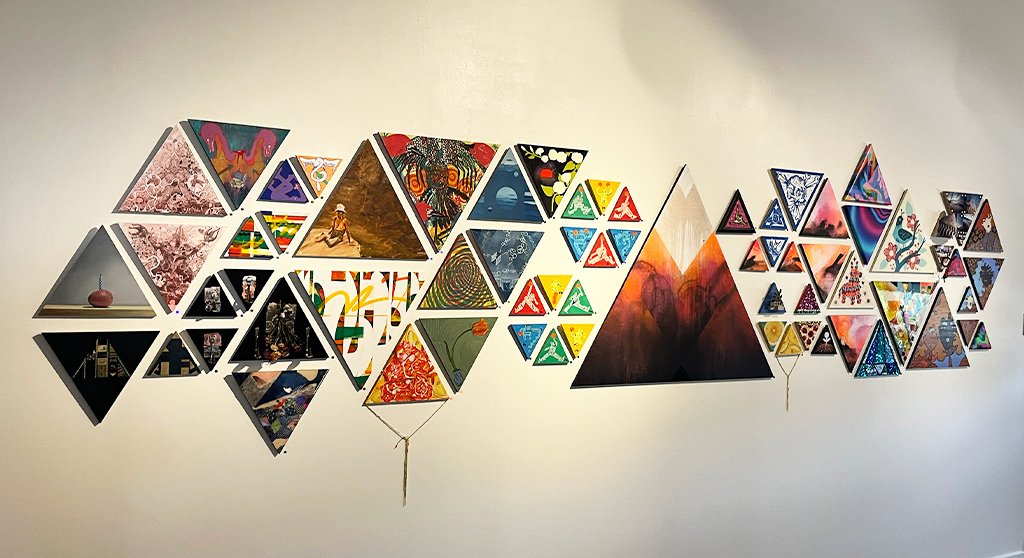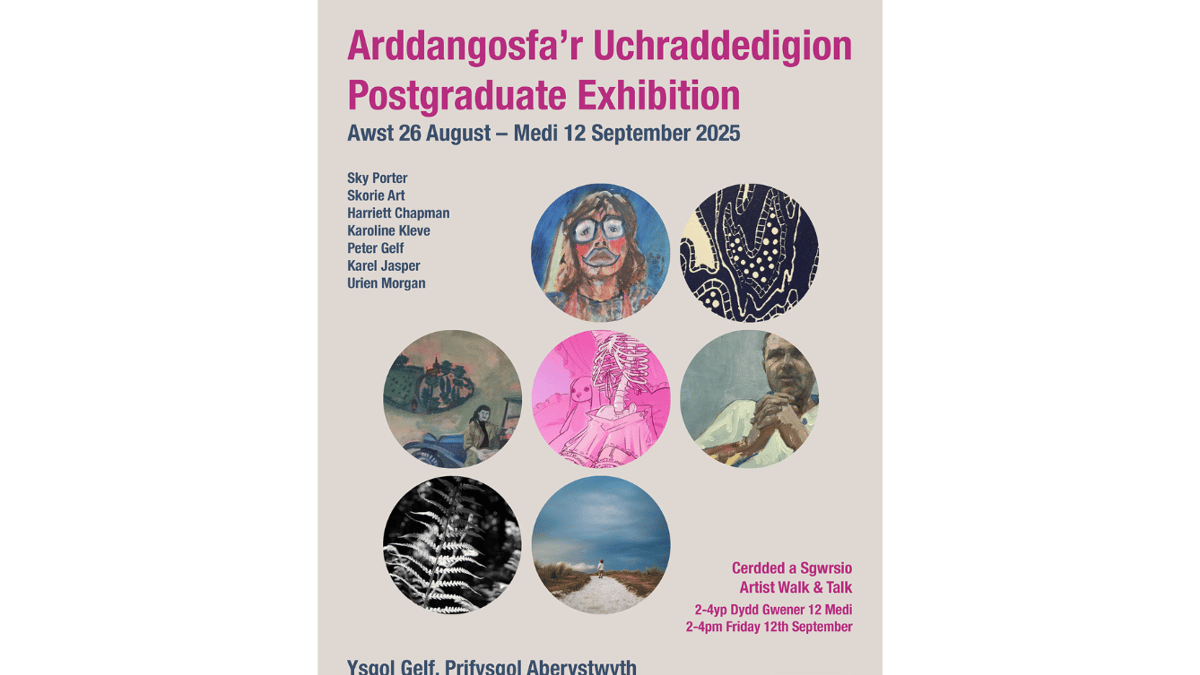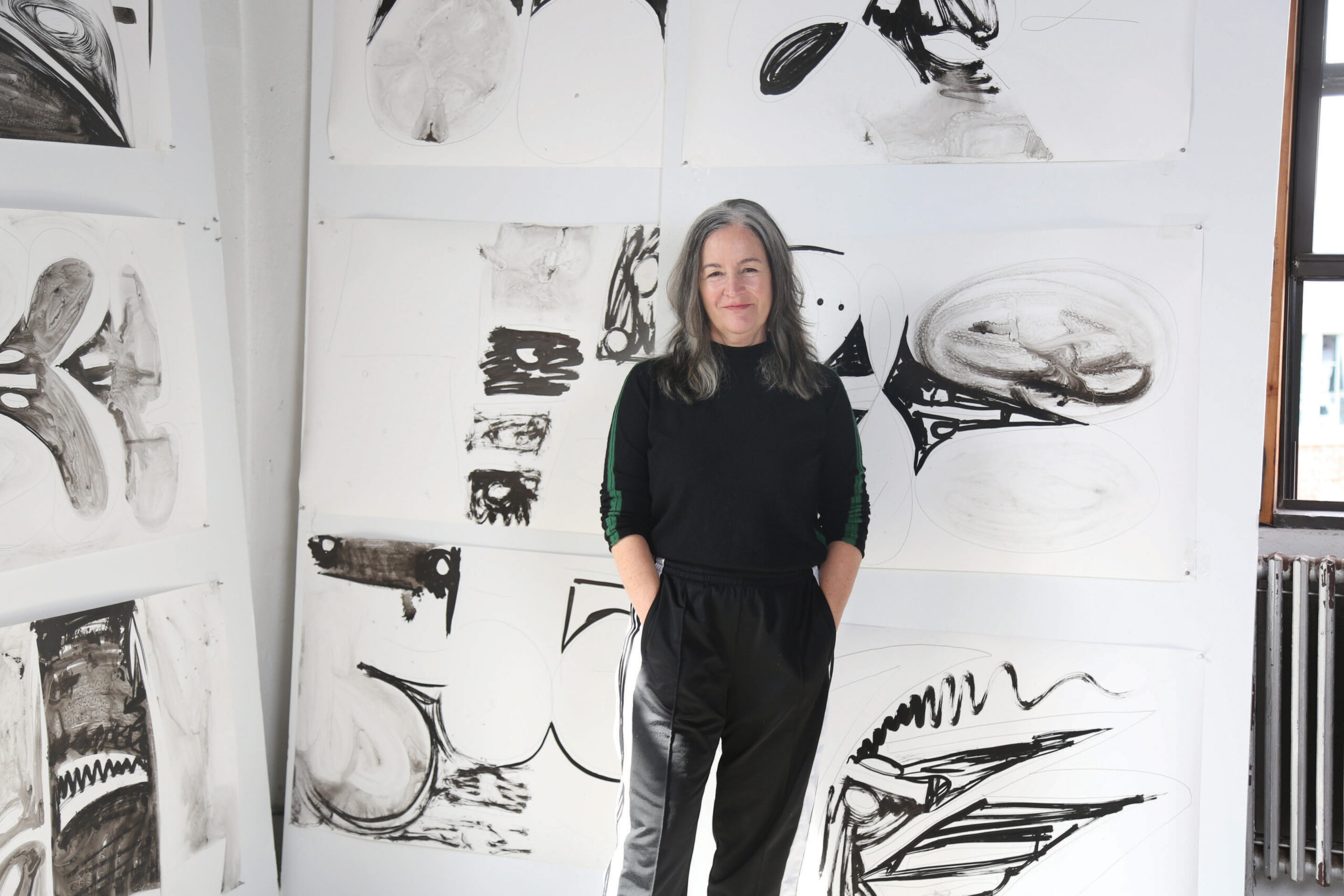
Suzanne McClelland, photographed by Elizabeth Brooks.
“Heads up!” reads a billboard. The text blurs past us as we take a public bus to see Suzanne McClelland’s show Highland Seer at Marianne Boesky Gallery. The show takes its folkloric title from a Scottish mystic, some guy who wrote a book after admiring soggy tea leaves. These days, we pull tarot cards with Marvel superhero imagery or share astrological alignments in the hopes of uncovering some knowledge that will stifle persistent insecurities. But the braver among us don’t pull cards or wish upon shooting stars. Instead, they look at abstract paintings, especially McClelland’s, which act as one-off divination devices.
The bus slows its movement and I take a gulp from our plastic-cardboard coffee cup. I refuse eye contact with the coffee grinds clinging to the bottom. Soon, the bus stops, and its canary-colored doors open to the gallery. It’s quiet, solitary. The world runs away from us because it doesn’t like its people, “who have kinship and similar belief systems… eating each other alive.” McClelland shares this with us as she walks us through her dozen or so abstract paintings hanging on tallish, white walls. The paintings, nearly drawings in their lighthearted drafting, trace things like language, speech, and sound. It’s no wonder her second husband and son are both percussionists. “Both Drew and Lucas are very minimal speakers,” she explains. “There’s all this thinking that goes on that is best put out in the world with line. So that’s what this whole exhibition is about, really.”
For this show, the paintings lark about, thumping and shouting, some even yelling out to one another. “Tag, you’re it.” It’s a game of predator chasing prey with no horizontal line. “This one is called Prey,” McClelland says, confirming my suspicions. It depicts something of a Wile E. Coyote head with a flimsy, elongated neck meeting Road Runner gaily eye to eye. “I think there’s something that happens in a lot of early animation that’s very playful, spatially. You can really convey with minimal lines a sense of a void, or a space that could be water or air.” Trained in photography, the artist takes a neat interest in measuring, weighing, and outlining incorruptible voids like dusty animation brawls rendered in tan and gray scribbles as seen in, 8dividedby8 pleinair or Infinity’s Twin (fire). Over there, Pacific blue skyspaces befog an empty cliff suggesting the end of a cartoon chase scene. And, just beyond, turquoise waters splash from gray dorsal fins. Some paintings have been edited by natural elements, either dried out from California’s golden hour or dampened from light Long Island swims and sweats. McClelland works outdoors. “I love the sea water, so I work out there [the North Fork]. And these paintings reflect that particular kind of light and environment.” Perhaps, the best kind of divination device gets you out of your head and in-motion. It’s now summer and a good reason to get out the door.
———
JOHNNY BELKNAP: Let’s not start with the book. Absolutely not.
SUZANNE MCCLELLAND: I mean, unless we want to do a reading. We could do a reading together.
BELKNAP: That would be fun.
MCCLELLAND: I agree. I think at the top of the press release, or at least the narration, there was an excerpt from reading tea leaves.
BELKNAP: Yeah, I saw that. Are you a tea drinker?
MCCLELLAND: Not really, no. I’m a coffee drinker.
BELKNAP: Is it espresso, or is it-
MCCLELLAND: I like espresso. I like strong coffee.
BELKNAP: Yeah, same. Do you ever do a nighttime espresso? It’s an afters habit I picked up staying in Florence a while back.
MCCLELLAND: No, because then I would be up all night. I like to drink mezcal at night and espresso in the morning.
BELKNAP: A great combination. Back to the invitation to read about the secrets of rotting leaves with you. What page have we landed on in the book?
MCCLELLAND: Okay, the Highland Seer’s book on Reading Tea Leaves says that, “the universe has been nudging us to ask questions from the beginning of time. Nature provides many tools to gain insight, and cultures all over the world have developed and shared these practices through the ages. In Europe, the practice of looking for symbols and images in everyday residues dates to medieval times when practitioners would melt lead or wax to interpret someone’s fate. Even wine sediments and coffee grinds have been consulted. But, the queen of all these substances is still tea. I’m not that interested in tea. It’s really more how we, in this particular culture, and especially right now, want some sign of what might happen in the future.”
BELKNAP: Yeah, “sign” is a good word choice. A sign comes and goes. A symbol has staying power.
MCCLELLAND: People look for omens. It’s like, everybody wants guidance. We look to the weathermen, we look to economists, we look to guides to try to help us navigate the gap between strategy and instinct. And actually, I think that’s what it is to make the kind of paintings that I make. Some painters work out elaborate plans and schemes for their work, and then execute it. I really like having an overall system in place with each painting, and then let the material give back. Sometimes, there are surfaces that give back something as soon as you do something to it. Like this one, these are done on raw cotton, and they’re made outdoors.
BELKNAP: What season was it when you made these paintings?
MCCLELLAND: I work outdoors all the time, but it depends on where I am. Each studio has a different setup, and none of these studios are huge cavernous operations. I don’t have a factory going or anything, which I think works for some people, but I like to work alone.
BELKNAP: Okay, cool.
MCCLELLAND: These are stained paintings that are made on this big gravel expanse that I put down outside of our place in Orient Village, which is out in the North Fork of Long Island.
BELKNAP: Oh, okay. How close to the water is it?
MCCLELLAND: It’s like a nine-minute walk. It’s really close.
BELKNAP: That’s so nice. Do you go in the morning?
MCCLELLAND: I swim twice a day.
BELKNAP: Really?
MCCLELLAND: And I swim up until Christmas, usually.
BELKNAP: Whoa, wonderful. Do you have encounters with animals?
MCCLELLAND: Yeah, turtles.
BELKNAP: Turtles.
MCCLELLAND: I grew up in very rural places, so I spent a lot of time out in the woods and near lakes. I love the sea water, so I work out there. And these paintings reflect that particular kind of light and environment. There’s a lot of reflected light, because it’s a little strip of land that sticks out there.
BELKNAP: Yeah. The turquoise and the foam, it feels very post-wave crash. 2010 stock market flash crash. Almost like a shark fin, too, right there. Survival of the fin-est.
MCCLELLAND: These are called, Infinity’s Twin.
BELKNAP: Okay.

Infinity’s Twin – earth, 2024. Mixed media on canvas. 98 x 78 inches.
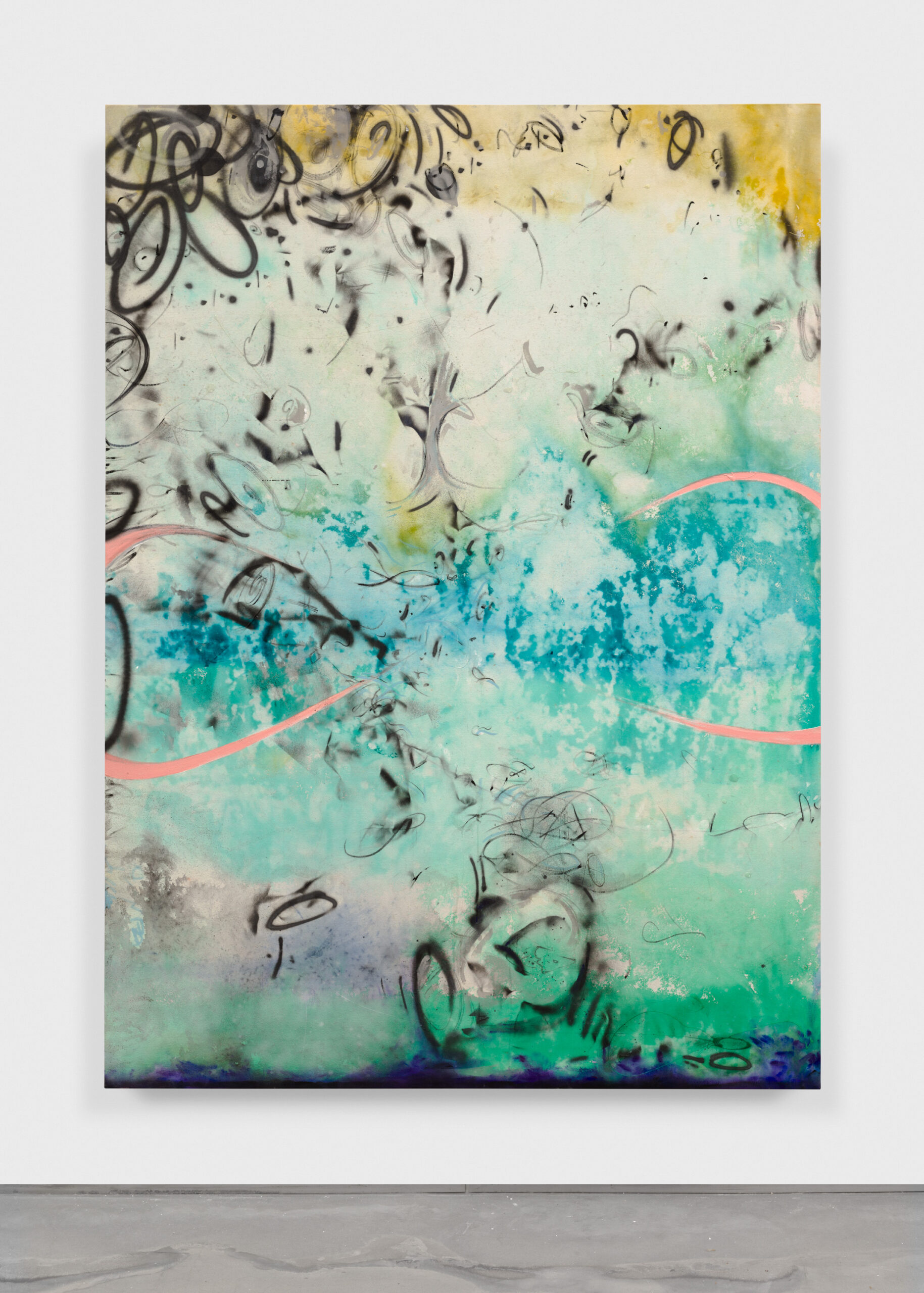
Infinity’s Twin – water, 2024. Mixed media on canvas. 106 x 77 inches.
MCCLELLAND: Because I was thinking a lot about these concepts of zero, and how zero was developed. It was developed as a Hindu principle, and then it developed further in Arabic cultures. And the Mayans had amazing imagery for their numbers, and the zero image is really amazing. I’d love to show that to you, although I don’t have that book with me. But all over the world, zero was used as a placeholder. It also has this association with the void and nothingness.
BELKNAP: Right, right. The idea of money is similar as it is, “Almost always something hovering between a commodity and a debt-token.” It cannot rest, you either exchange money for a material good or a service or you are paying back for what you already have on you. Energy is another thing where zero is a placeholder. Absolute zero – 0 Kelvin or -273.15 degrees Celsius – is the temperature at which all motion of particles ceases. It’s really amazing, as you say, a placeholder, something impossible to actually reach. Tell me more about this, Infinity’s Twin.
MCCLELLAND: These paintings are part of a group of elements. This is, Infinity’s Twin, and there’s, Earth. This one’s, Fire. The one behind us is, Water. And then, I have Air back at home. And then there’s Void, which I haven’t finished yet. Those five are like, they’re the same ones, rough scale.
BELKNAP: Wait, quickly, why did you keep Air and Void?
MCCLELLAND: Well, I just haven’t finished it.
BELKNAP: Okay, got it. What could there be to finish–
MCCLELLAND: These are ongoing. This exhibition is the first time I’ve done a gathering of work. I emphasize that term gathering because I collected work from that studio. And the studio I work in downtown L.A., which is a much larger space, and a rougher space, and very urban. And the paintings feel different. But, we also decided to hang these… Even though most people wouldn’t hang paintings this size in a tiny room like this, we felt like they work well because they have a lot of depth because of the staining.

Infinity’s Twin (fire), 2024. Mixed media on canvas. 106 x 83 inches.
BELKNAP: Yeah. Transference.
MCCLELLAND: And I spent a lot of time with color-filled artists in the eighties. My first husband was a color-filled painter.
BELKNAP: Who was that?
MCCLELLAND: Peter Bradley. He introduced me to Clement Greenberg back in those days. And Anthony Caro and I didn’t ever meet Ken Nolan, but they had been friends. If you look at the way a lot of that work was made, it was very much about this fluid soaking, like the pigment would soak into the fabric. You really have a sense of the fabric in a lot of the work. I had started as a photographer. I was a photographer until I came to New York.
BELKNAP: That’s right, okay.
MCCLELLAND: I did paint in college, but I lived in the dark room. And in the dark room, you see that image slowly, slowly appear.
BELKNAP: Right. More transference of materials, energy-in-motion.
MCCLELLAND: And, I always was disappointed in the end about the framing of it. It was like the camera always reasserted itself. I didn’t do setups or still life. I didn’t do fashion or anything like that, although I worked for fashion photographers when I first moved to New York doing sets and stuff. But I worked in dark rooms for people.
BELKNAP: It’s funny, the element. They’re very full of subject-hood, subjectivity. They feel like signs, I guess. Signs come and go. Symbols have staying power.
MCCLELLAND: They have signs because there’s zeros and infinity. They’re very explicit signs. And this is, Zero. This one is called, Zero to Infinity.
BELKNAP: That one, okay. Buzz Lightyear stretched out by Woody crossbars.
MCCLELLAND: Mm-hmm. Most of the work in this show is about asserting lines, and making drawing the most important part of the work. Drawing is often thought of as a thing that you begin a painting with, or it’s something that is underneath a painting. It’s buried. And, I like to expose it as the primary materiality of the work, because for me, drawing is close to… It tells us how someone’s thinking more than painting does.
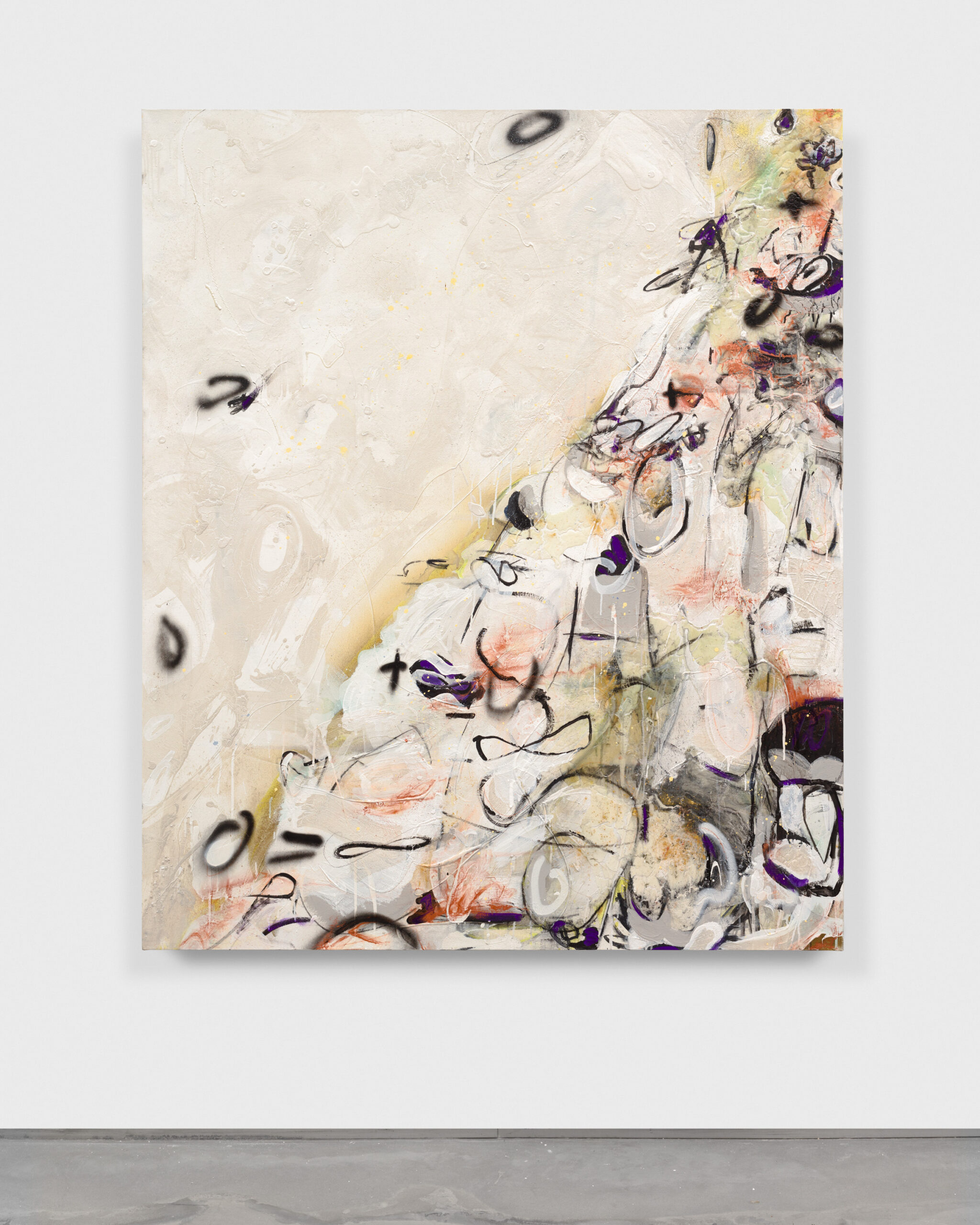
Zero to Infinity-Go Figure, 2024. Oil and acrylic on canvas. 72 x 60 inches.
BELKNAP: Got it. What do you think when painting?
MCCLELLAND: You’re all so young. You probably never learned to do handwriting. But, a lot of people, like my son who’s 23. When he would write, he would write, and all the letters are the same space with the same distance away from each other, even words. It would be like, “What are you talking about?”And he’s a very intelligent kid. When he wrote on a computer, he had very interesting thoughts. But, the handwriting was like, those are letters, and then you’d have to try to put them together into clumps to make the words. Anyway, very interesting to me that writing and drawing are so–
BELKNAP: Intertwined.
MCCLELLAND: … Close.
BELKNAP: Yeah, yeah. What’s your son’s name?
MCCLELLAND: Lucas. He’s a percussionist. Like his dad. His dad’s a percussionist.
BELKNAP: Oh, cool. Everyone thinks drummers are the wildcards. It’s the bassists in the history books: Sid Vicious of the Sex Pistols, Paul Simonon of The Clash, Flea of Red Hot Chili Peppers, etc. Drummers have chill.
MCCLELLAND: This is the second husband.
BELKNAP: Okay. The more the merrier, I hope.
MCCLELLAND: It is.
BELKNAP: Life’s too short not to have fun and get all the support you can from everyone you’ve met.
MCCLELLAND: Both of them, both Drew and Lucas are very minimal speakers. They don’t talk very much. They do one word. Sometimes you ask them something and you get one word back. They both write well though. There’s all this thinking that goes on that is best put out in the world with line. So that’s what this whole exhibition is about really.
BELKNAP: Yeah, okay.
MCCLELLAND: It’s a hyper-reduced landscape. They’re very schematic really, all three of these. They just show you where some sort of division is of land and sky, but there’s not really a horizon.
BELKNAP: Wait, that’s so crazy. I didn’t see these over here. Like, these give me the munchies. Deep dive into the giant rectangle paintings and I spy a semblance of frozen animals-in-motion. Prompting to prey on their nibbles: Tony the Tiger’s Frosted Flakes, Toucan Sam’s Froot Loops, Trix Rabbit’s loony fruit crunchy things. No wait, that one’s a Looney Tunes.
MCCLELLAND: There’s no horizon line.
BELKNAP: Is that what’s loony, spiraling into Toucan Sam’s Froot Loops? I didn’t see the roadrunner.
MCCLELLAND: Yeah, this one is called, Prey.
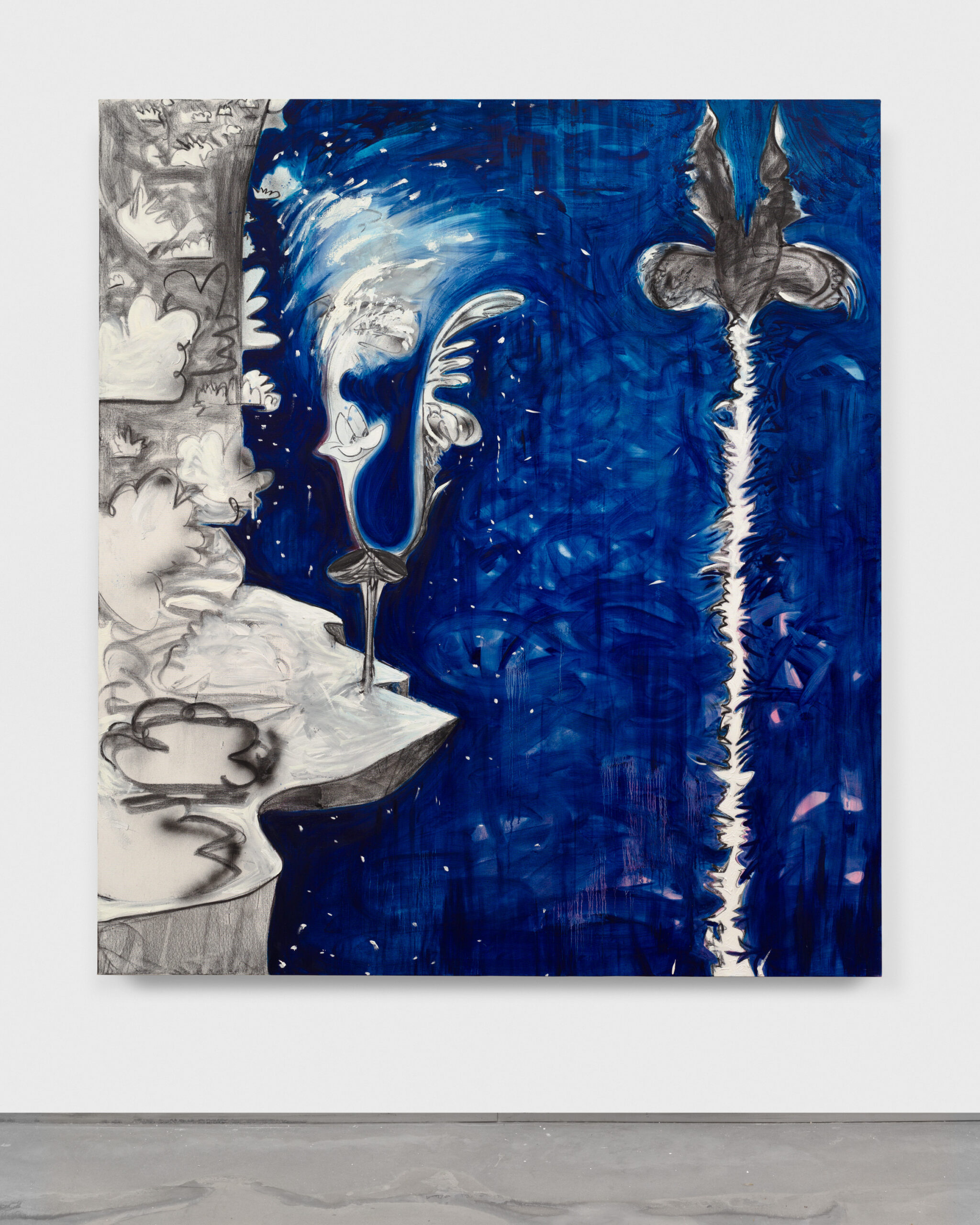
PREY (heads or tails), 2024. Charcoal and oil on canvas. 84 x 72 inches.
BELKNAP: When I was looking at this one when I first walked in, this blue, I was like, “This reminds me of a fucking cartoon.” The dust stuff that lingers a bit longer at the tail end of a cartoon chase scene, be it cereal or TV show.
MCCLELLAND: Oh, but you didn’t see it? The fucking or the cartoon?
BELKNAP: I didn’t even see that. Fuck. Wait, that’s actually really crazy. The shadow, it’s literally the dust. Is that actually possible? Unless it’s the outline of the predator by way of its shadow in the prey’s dust. Everything from childhood to this “art world” thing feels like a former shadow of itself.
MCCLELLAND: It traces gravity in some way. If you do look at them, I hope that you gather some kind of connection to where a gravitational force might be.
BELKNAP: Inside of the painting?
MCCLELLAND: In the painting, so you can feel that things are leaning or weighing on each other.
BELKNAP: I feel that in that one [points] and this one [points].
MCCLELLAND: This one has more of a rocking feeling. Also, the gray, I read it as being in front of everything else behind it. But then, the red will assert itself and try to push itself forward. And this has more of a falling, because it’s so stained, it’s so embedded in the pocket. It’s probably the roughest. These two out here were done outdoors. They’re made outside, and then they have… The sun bleaches them a little bit.
BELKNAP: Right, which is a nod to your earlier photography practice.
MCCLELLAND: It is, yeah. And it’s like chemistry. I can look at these as Petri dishes in a sense.
BELKNAP: Or cereal bowls. Can we get into the roadrunner one?
MCCLELLAND: Yeah.
BELKNAP: The narrative quality of animals in the human kingdom and this sort of dazed zaniness makes me think of… do you know Bill Peet, the illustrator? He was the guy that did, I don’t know, loads of early animated films first as inbetweeners for Donald Duck and then full-on for Mister Disney himself. I think he was the one who did both One Hundred and One Dalmatians and The Sword in the Stone, the only time a Disney animator was also the sole storyteller back then. He liked stories where animals visit the human kingdom but then they return home to their animal kingdom and a human gets dragged along into it. I suppose the stories get at the slippage that humans are always in the animal kingdom pretending otherwise, that’s the drama. He did Fantasia and Dumbo and Pinnochio and Peter Pan, too. He made lots of wonderful children’s books after a falling out with Disney and an illustrated biography where he admits to drawing Captain Hook in the likes of Disney.
MCCLELLAND: I think there’s something that happens in a lot of early animation that’s very playful, spatially. You can really convey with minimal lines a sense of a void, or a space that could be water or air. Here I was thinking about that relationship. The thing I love about that particular cartoon is the relationship between the prey and the predator, and the fact that the predator who’s the coyote is constantly putting himself in the position of the prey. He becomes prey to himself, which is how it feels like a lot of the world is going right now.
BELKNAP: Why? Are we hunting ourselves?
MCCLELLAND: Well, there’s a lot of self-annihilation and self-erasure. People who have kinship and similar belief systems are eating each other alive.
BELKNAP: I know. I just don’t get it.
MCCLELLAND: I don’t either. The one thing that I think contributes to this kind of cannibalism that’s happening in the world. It’s social cannibalism, it’s competition. In the ’70s when I grew up, when I was a teenager, nobody would ever admit to being competitive. It was so wrong to be competitive. So I don’t think competitively, but the conditions around me set up competitive environments.

2dividedby2 pleinair, 2024. Water-based paint and charcoal on canvas. 72 x 60 inches.
BELKNAP: Right.
MCCLELLAND: And anytime you’re making a living, it seems to present itself. It’s not a bad thing, but I do think that it contributes to this lack of resolution and lack of repair, because people are trying to get ahead.
BELKNAP: Of what?
MCCLELLAND: Of the other. It’s a tough time right now. Everybody keeps saying that, but it’s partly because it’s really hard for people to forgive each other, and it’s hard for people to get out of the cycle of revenge. Even just interpersonally, people go after each other, and then when they realize, maybe they actually have more in common then they knew, but they don’t necessarily take the time to get back to that place. I just did this workshop at Hunter [College]. I really loved those grad students there in the MFA program. And we watched Nashville, the Robert Altman film and looked at two Bruegel paintings.
BELKNAP: Which Bruegel’s?
MCCLELLAND: “Children’s Games” and “Tower of Babel,” which is why I use that mound a lot, because it refers to the Tower of Babel. These two paintings here are blind contour drawings of myself drawing. I have never inserted a figure into a painting except when I was in college. And mostly because I think of it as a repetitive thing. To repeat oneself isn’t as interesting to me as creating a space of otherness, but, in this case, all four of these paintings had to do with me measuring my own body within the frame, so that’s why they’re hung together.
BELKNAP: Got you. Bruegel feels freakishly relevant. And opacity. The art critic T.J Clark. has that book that came out in 2018, Heaven on Earth: Painting and the Life to Come, where he talks about how the “muteness” of painting is undermined by the awkward proclamations of language. I guess what I mean is that we have a codependent relationship with language, it is how we dumb, and numb, ourselves dumb. Language is often ineloquent that’s why designers and painters and poets work in other kinds of languages, through signs and symbols. Another way to say this is a favorite passage from a favorite book that goes: “What does ‘decisional’ mean?” a small boy asked. ‘It means we might have to land in Hyannis,’ his mother said. It is hard to understand how anyone learns anything.” That tiny scene from Renata Adler’s Speedboat hilariously outlines how language is often ineloquent.
MCCLELLAND: I’ve done a lot of blank contour drawing because it’s a great way to get more attached to the object than to the painting that you’re making. I appreciate having that third thing, that thing outside of the artwork and outside of myself.
BELKNAP: Yeah. Maybe the third thing is a placeholder-entity or a nothingness, a void.
MCCLELLAND: Anyway, I don’t think I can talk any more unless you need to.
BELKNAP: No, we don’t have to.
MCCLELLAND: That was a lot.

Installation view of Highland Seer. Photo by Lance Brewer. Courtesy of Marianne Boesky Gallery and Suzanne McClelland.

